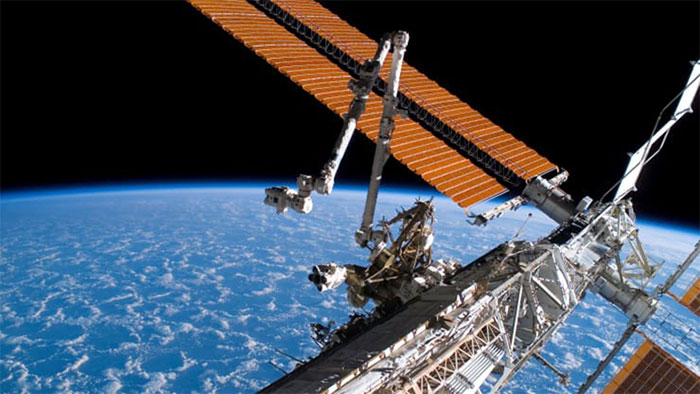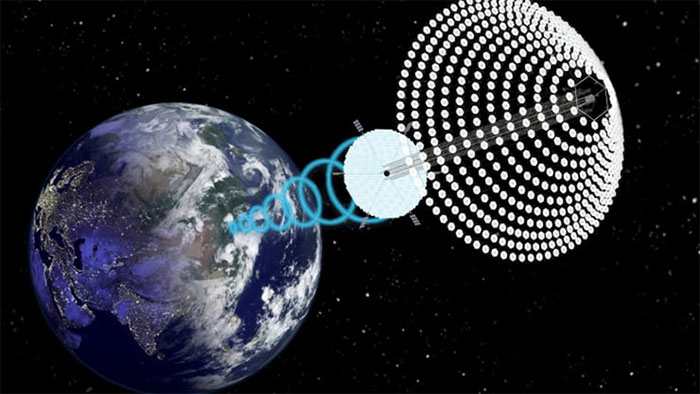With the increasing energy demand on Earth every day, scientists have proposed the ambitious idea of building solar power stations in space.
Significant Benefits
Famous American science fiction writer Isaac Asimov mentioned the prospect of harvesting solar energy in space as early as 1941. By the 1970s, after conducting experiments on solar energy transmission, aerospace engineer Peter Glaser managed to convince NASA to allocate a budget for further research. However, this project was affected by changes in the U.S. administration. It wasn’t until 1999 that NASA revisited the idea, ultimately deciding not to pursue it. Recently, a NASA spokesperson stated that the agency is currently not researching solar energy in space.

Solar panels installed on the International Space Station (ISS). (Photo: Getty Images).
Mark Hopkins, a former NASA employee, shared with CNBC: “If you can lower the cost of solar energy in space, you will capture a large portion of the world’s energy market.” This system operates by collecting solar energy in space and using lasers to transmit it back to Earth. The advantage of this method is that electricity can be transmitted to nearly everywhere on Earth, except Antarctica and the Arctic.
Therefore, Professor Ali Hajimiri at the California Institute of Technology (Caltech) believes that the solar energy system in space could provide power to locations that do not frequently receive sunlight, such as Northern Europe and many areas in Russia.
According to United Nations projections, by 2050, the global population will reach 9.6 billion people, making it essential to find green energy sources that can meet the increasing demands of the world. Professor Ali Hajimiri told Forbes: “In space, there is no cycle of day and night, and there are no clouds or weather effects, so solar energy will be continuous.”
Professor Michael Byers at the University of British Columbia in Vancouver (Canada) assessed that the biggest issue with this plan is time. According to him, it will take decades to establish a solar power station in space. Meanwhile, solar power systems on Earth are also making progress in terms of cost and efficiency.
Mr. Byers stated: “You can install solar panels anywhere, like on rooftops. Many small projects
will be better than one large project.”
Many Countries Eyeing the Opportunity

Graphic of a solar power station in space by John Mankins. (Photo: CNBC).
In December 2019, Xinhua News Agency reported that the Chinese Academy of Space Technology (CAST) announced plans to complete a solar power station in space by 2035.
China recently declared that within the next decade, it will complete tests for high-voltage energy transmission and wireless energy. These are essential factors for operating a solar energy system in space.
Beijing’s plan also includes launching small and medium-sized solar panels into the stratosphere, aiming to produce electricity by the 2021-2025 period. Following that, by 2030, they plan to establish a solar power station capable of generating at least 1 megawatt of electricity, with the goal of a commercial-scale solar power plant by 2050.
Mr. Mankins commented: “About a decade ago, China seriously evaluated this, and about five years ago, they began attending international conferences.” The former NASA employee added, “At this point, China has made certain progress. There is a possibility they could achieve this by 2030.”
During his 25 years at NASA, John Mankins proposed many ideas to enhance understanding of solar energy in space. He nearly realized this concept in the 2000s with support from the White House under President George W. Bush and the U.S. Congress, receiving accolades from the National Academy of Sciences and the Department of Defense. However, the program was not implemented for various reasons.
Mr. Mankins currently runs a private aerospace company called Artemis Innovation Management Solutions, aimed at finding ways to transmit electricity harvested from solar energy in space back to Earth.
While NASA has not made any moves, a group of American scientists at the California Institute of Technology claimed to have invented a device that can capture and transmit solar energy from space to Earth. In 2015, they reached an agreement with Northrop Grumman for $17.5 million dedicated to research. Meanwhile, scientists in India, Japan, and various European countries are also researching solar energy models in space.





















































